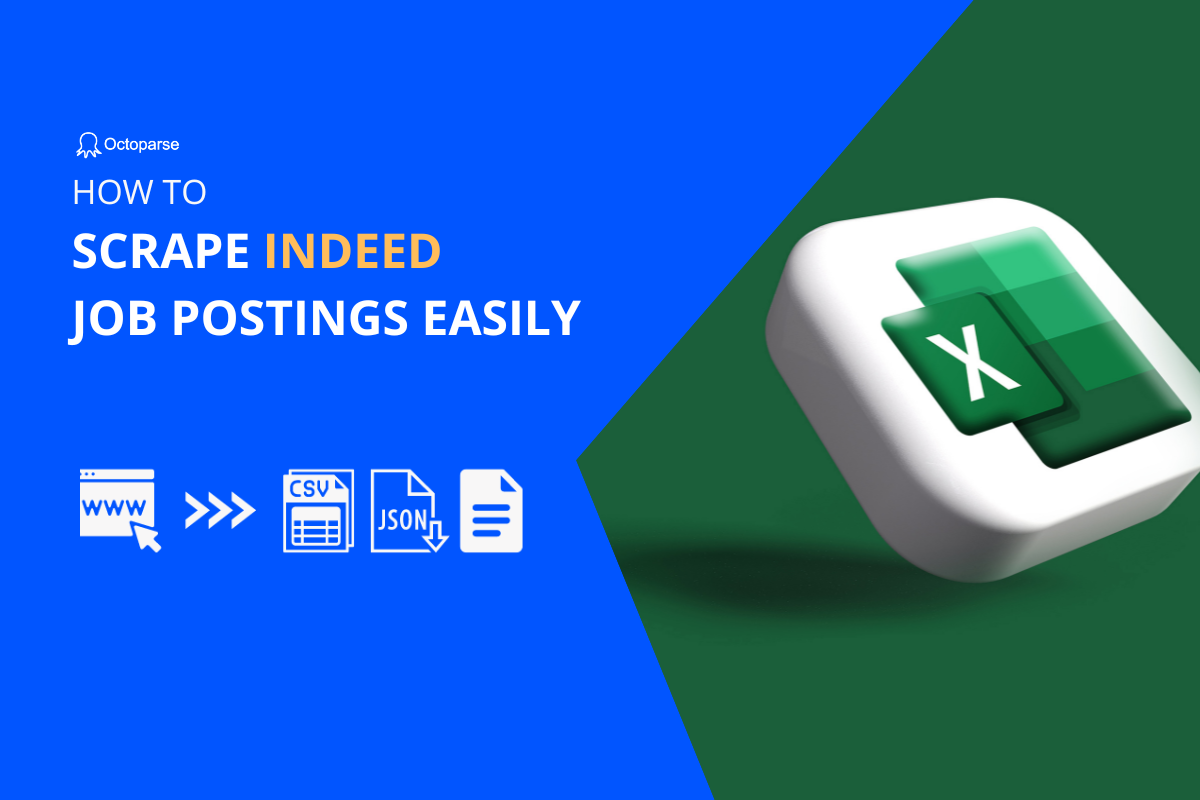The online job market has undoubtedly overridden in-person hiring activities. This is especially true when most cities around the globe face rounds of lock-down and more jobs shift to a remote mode since COVID-19. In this sense, scraping job postings data helps not only institutions and organizations but also individual job seekers.
What You Should Know Before Scraping Job Data
In the beginning part, we will give an introduction to the concept of the job posting, how can scraped data be used, and the scraping challenges. These will help you have a better understanding of job scraping.
1. About Job Posting
Job scraping is to gather job posting information online in a programmatic manner. This automated way of extracting data from the web helps people get job data efficiently and build a resourceful job database by integrating various data sources into one. Job scraping is the use case of web scraping in the job area and job data parsing, analysis, and managing may come after the extraction process is done.
Where to fetch job data? Company’s career pages, giant big boards like Monster, Glassdoor, or Indeed, personal job aggregator websites, and job portals serving all sorts of niche markets are important sources for people who are applying for job scraping. From all these sources, job scraping can easily get you information such as job title, job description, location, and compensation.
2. How Is Job Scraping Data Used?
According to the report made by Gallup, 51% of employees keep an eye on new opportunities online and 58% of job seekers look for jobs online. In recent years, social media recruiting has become an essential way to seek quality hires as well.
These needs for online recruiting resources give rise to the business of job boards and job aggregator websites. This kind of aggregator website is really making money.
Job Data Uses in Practice
- Fueling job aggregator sites with fresh job data.
- Collecting data for analyzing job trends and the labor market.
- Tracking competitors’ open positions and compensations to get yourself a leg up in the competition.
- Finding leads by pitching your service to companies that are hiring for the same.
- Staffing agencies scrape job boards to keep their job databases up to date.
And trust me, these are only the tip of the iceberg, job data create values in more unexpected ways.
3. Challenges for Scraping Job Postings
Much different from job advertising that gives employers a direct and far easier way to capture clean and structured job data, job scraping often struggles several challenges such as inconsistent site structures and blocked access.
Gathering Job Data from Multiple Sources
First and foremost, you’ll need to decide where to extract this information. There are two main types of sources for job data:
- Major job aggregator sites like Indeed, Monster, Naukri, ZipRecruiter, Glassdoor, Craiglist, LinkedIn, SimplyHired, reed.co.uk, Jobster, Dice, Facebook jobs, etc.
- Every company, big or small, has a career section on their websites. Scraping those pages on a regular basis can give you the most updated list of job openings.
- Niche recruiting platforms if you are looking for jobs in a certain niche, like jobs for the disabled, jobs in the green industry, etc.
Anti-scraping Techniques That Block Job Scraping
Next, you’ll need a web scraper for any of the websites mentioned above.
Large job portals can be extremely tricky to scrape because they will almost always implement anti-scraping techniques to prevent scraping bots from collecting information from them. Some of the more common blocks include IP blocks, tracking for suspicious browsing activities, honeypot traps, or using Captcha to prevent excessive page visits.
Well, there are still ways to bypass anti-scraping techniques and straighten the thing out.
High Cost for Job Crawlers Building and Maintenance
On the contrary, the company’s career sections are usually easier to scrape. Yet, as each company has its own web interface/website, it requires setting up a crawler for each company separately. Such that, not only the upfront cost is high but it is also challenging to maintain the crawlers as websites undergo changes quite often.
3 Methods to Scrape Job Postings
1. Using a job web scraping tool
Technologies’s been advancing and just like anything else, web scraping can now be automated. There are many helpful web scraping software that is designed for non-technical people to fetch data from the web. These so-called web scrapers or web extractors transverse the website and capture the designated data by deciphering the HTML structure of the webpage. Most web scraping tools support monthly payments ($60 ~ $200 per month) and some even offer free plans that are quite robust.
You’ll get to “tell” the scraper what you need through “drags” and “clicks”. The program learns about what you need through its built-in algorithm and performs the scraping automatically. Most scraping tools can be scheduled for regular extraction and can be integrated into your own system.
Web Scraping Tool Application
Pros:
- Budget-friendly.
- Non-coder friendly.
- Scalable. Easily supports projects of all sizes, from one to thousands of websites.
- Fast turnaround.
- Complete control in the data extraction.
- Low maintenance cost.
Cons:
- Learning curve. Though this software is much easier than coding, some of them also take much time to learn.
- Compatibility. There’s never going to be 100% compatibility when you try to apply one tool to literally millions of websites.
- Captcha. Some web scraping tools cannot solve Captcha.
Octoparse is the best web scraping tool we recommended if you choose this method. It’s relatively easy to use as it provides an auto-detect mode so that you just need to copy and paste the target link and finish the whole process with a few clicks. Octoparse also provides advanced functions like CAPTCHA solving, IP rotation, Task scheduling, API, etc. You can watch the video below to learn more about it.
2. Hiring a web scraping service
These companies provide what is generally known as “managed service”. Some well-known web scraping vendors are Scrapinghub, Datahen, Data Hero, etc. They will take your requests in and set up whatever is needed to get the job done, such as the scripts, the servers, the IP proxies, etc.
Data will be provided to you in the format and at the frequency required. The charge is based on the number of websites, the amount of data, and the frequency of the crawl. Some companies charge additional for the number of data fields and data storage.
Website complexity is, of course, a major factor that could have affected the final price. For every website setup, there’s usually a once-off setup fee and a monthly maintenance fee.
Data As a Service (Daas)
Pros:
- No learning curve. Data is delivered to you directly.
- Highly customizable and tailored to your needs.
Cons:
- High costs ($350 ~ $2500 per project + $60 ~ $500 monthly maintenance fee).
- Long-term maintenance costs can cause the budget to spiral out of control.
- Much time is needed for communication and development (3 to 10 business days per site).
3. In-house web scraping setup
Doing web scraping in-house with your own tech team and resources comes with its perks and downfalls. Web scraping is a niche process that requires a high level of technical skills, especially if you need to scrape from some of the more popular websites or if you need to extract a large amount of data on a regular basis.
Starting from scratch is tough even if you hire professionals, these development guys are expected to be well-experienced in tackling unanticipated obstacles.
Owning the crawling process also means you’ll have to get the servers for running the scripts, data storage, and transfer. There’s also a good chance you’ll need a proxy service provider and a third-party Captcha solver. The process of getting all of these in place and maintaining them on a daily basis can be extremely tiring and inefficient.
What’s more, the issue of legality shall be considered. Generally speaking, public information is safe to scrape, and if you want to be more cautious about it, check and avoid infringing the TOS (terms of service) of the website. Hiring a professional service provider will surely reduce the level of risk associated with it.
In-house Web Scraping Team
Pros:
- Complete control over the crawling process.
- Fewer communication challenges, and faster turnaround.
Cons:
- High cost. A troop of tech costs a lot.
- Difficulties in hiring.
- Infrastructure requirements.
- Maintenance headache. Scripts need to be updated or even rewritten all the time as they will break whenever websites update layouts or codes.
- Legal risks.
Conclusion
To sum up, there are surely going to be pros and cons with any one of the options you choose. The right approach should be one that fits your specific requirements (timeline, budget, project size, etc.). Obviously, a solution that works well for businesses of the Fortune 500 may not work for a college student. That said, weigh in on all the pros and cons of the various options, and most importantly, fully test the solution before committing to one.




